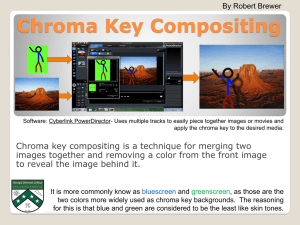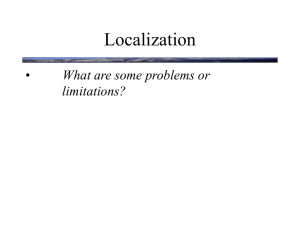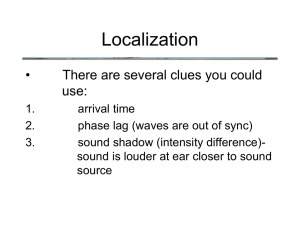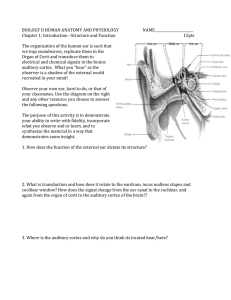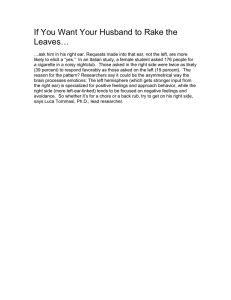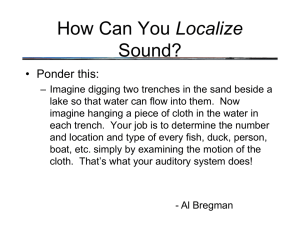Localization
advertisement
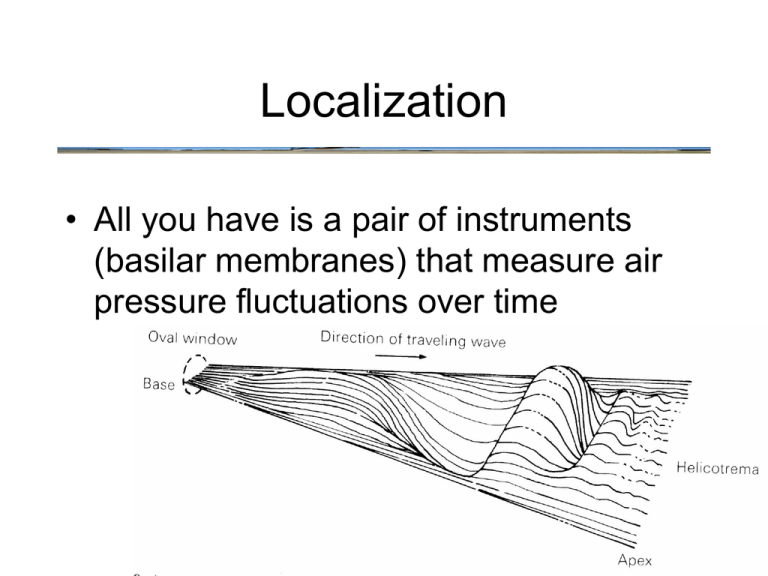
Localization • All you have is a pair of instruments (basilar membranes) that measure air pressure fluctuations over time Localization • There are several clues you could use: Localization Left Ear Right Ear Compression Waves Localization • 1 There are several clues you could use: arrival time - sound arrives first at ear closest to source Localization Left Ear Right Ear Compression Waves Localization • 1. 2. There are several clues you could use: arrival time phase lag (waves are out of sync) wave at ear farthest from sound source lags wave at ear nearest to source Localization Left Ear Right Ear Compression Waves Localization • What are some problems or limitations? Localization • Low frequency sounds aren’t attenuated by head shadow Sound is the same SPL at both ears Left Ear Right Ear Compression Waves Localization • Left Ear High frequency sounds have ambiguous phase lag Left Ear Right Ear Right Ear Two locations, same phase information! Localization • These cues only provide azimuth (left/right) angle, not altitude (up/down) and not distance Left Ear Right Ear Azimuth Localization Additional cues: Localization Additional cues: Head Related Transfer Function: Pinnae modify the frequency components differently depending on sound location Localization Additional cues: Room Echoes: For each sound, there are 6 “copies” (in a simple rectanguluar room!). Different arrival times of these copies provide cues to location of sound relative to the acoustic space Auditory Scene Analysis • Sounds don’t happen in isolation, they happen in streams of changing frequencies • How does the system group related auditory events into streams and keep different streams separate? Auditory Scene Analysis • Solving this problem is called Auditory Scene Analysis • One important principle is proximity –in pitch, time, or spatial location Auditory Scene Analysis • Effect of timing proximity: Slow Fast Auditory Scene Analysis • Effect of timing proximity: Slow Fast Do you hear this? Or this? Auditory Scene Analysis • Effect of pitch proximity: far close Auditory Scene Analysis • Effect of pitch proximity: Do you hear this? Or this? far close Auditory Scene Analysis • Effect of proximity: – auditory system groups together events that happen close together in time and frequency Pitch and Music Pitch • Pitch is the subjective perception of frequency Period - amount of time for one cycle Frequency - number of cycles per second (1/Period) Air Pressure time -> Pitch • Pure Tones - are sounds with only one frequency f = 400 hz f = 800 hz Tone Height • Tone Height is our impression of how high or low a sound is • but there’s something more to our impression of how something sounds than just its tone height… Chroma • Tone Chroma is the subjective impression of what a tone sounds like • Notes that have the same Chroma sound similar 500 Hz 400 hz 800 Hz Chroma • Tones that have the same Chroma are octaves apart Chroma • chroma is best represented as a helix • chroma repeats every octave • tones with the same chroma are above or below each other on a helix Chroma • Tones that are octaves apart have the same chroma • one octave is a doubling in frequency Chroma • frequency is determined (in part) by location of stimulation on the basilar membrane Chroma • frequency is determined (in part) by location of stimulation on the basilar membrane • but that relationship is not linear (it’s logarithmic) Chroma • doublings of frequency map to equal spacing on the basilar membrane
